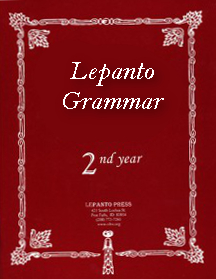Books in this Lepanto Grammar series are reprints of the 1958 editions of the Voyages in English series. (There are also newer, heavily revised editions published by Loyola Press.) These “originals” are distinctively Catholic. Character building is embedded throughout the books. The second half of each text focuses on grammar, while the first half covers the range of other language-arts activities. The content is less challenging at the lower levels than in the newer versions of this series. The content is broader and more challenging than newer versions as you move past the early grade levels. The textbooks are not consumable.
A variety of exercises accompany each lesson in the text. Many of these exercises should be done orally. The teacher's manual for each textbook has teaching instructions and answer keys for the textbook questions.
The consumable companion grammar workbook for each textbook has additional exercises. There are separate answer keys for the grammar workbooks. The workbooks are not stand-alone items but reinforce lessons in the textbooks. If you are using both the textbook and workbook, you might not need to have students complete every exercise in both books.
Lepanto Grammar 1
As mentioned above, the early levels in this series are less challenging than many other language arts programs. Little grammatical vocabulary is used. For example, in presenting plural forms they use the heading, “Words for More than One.” If you are concentrating on phonics, beginning reading, and handwriting, this will give you adequate coverage of language arts for first grade. No answer key is necessary but there is a combined grades 1 and 2 teachers manual that has teaching suggestions and answers.
Lepanto Grammar 2
Second-grade level adds adverbs to the parts of speech to be studied, and it continues work on prefixes, suffixes, contractions, subject-verb agreement, and other grammatical concepts. Writing activities include friendly letters, “how-to” paragraphs, and very short reports. The only Catholic reference I found here was the inclusion of abbreviations for Father and Sister as forms of address. While some fantasy appears in the literature, I found nothing objectionable. As with the first-grade program, the teacher edition is intended to be the source of instruction, but the student books can be used on their own for less thorough and comprehensive coverage.
Lepanto Grammar 3
not reviewed
Lepanto Grammar 4
not reviewed
Lepanto Grammar 5
Grammar concepts are more complex, and topics such as articulation, choral speaking, and interpretation of diacritical markings are covered. Illustrations are minimal, so even though some are dated in appearance, it matters very little. Among topics covered in Book 5 are group discussions, “judging talks,” parliamentary procedure, choral speaking, paragraph construction, outlines, writing poetry, dictionary use, letter writing, book reports, drama, radio broadcasts, and a wide range of grammatical concepts including parts of speech through prepositions, interjections, and conjunctions. Diagramming instruction begins with this level.
Lepanto Grammar 6
not reviewed








